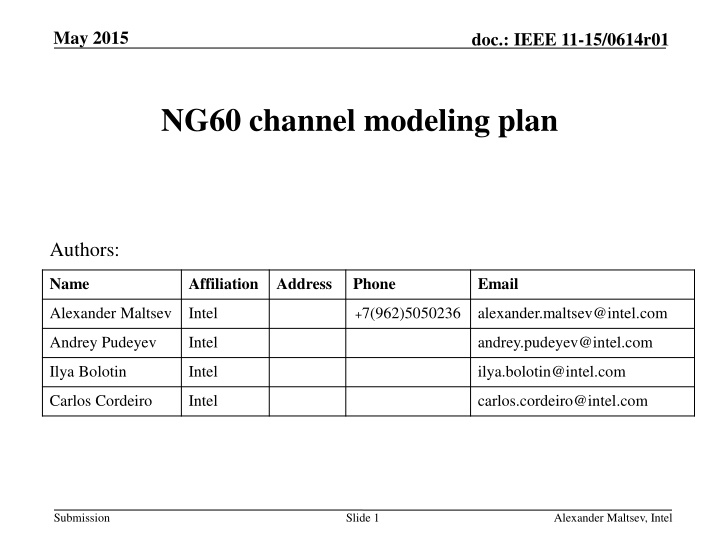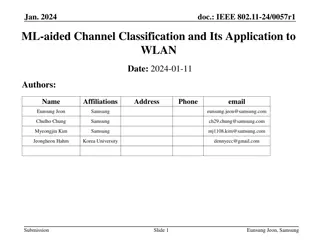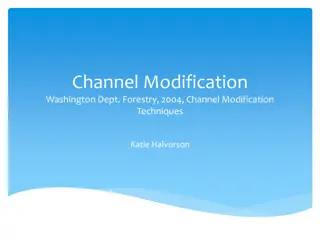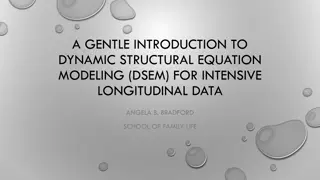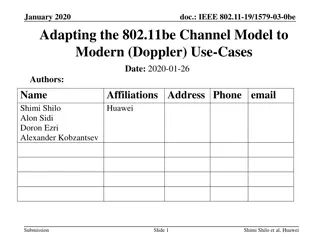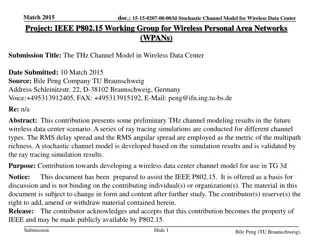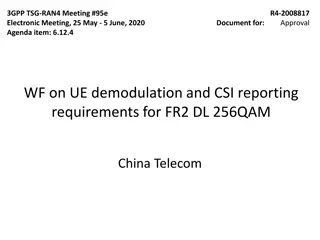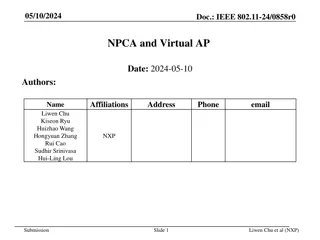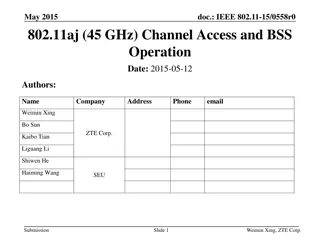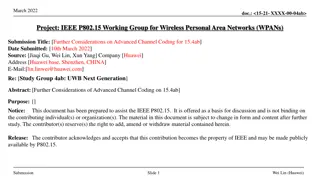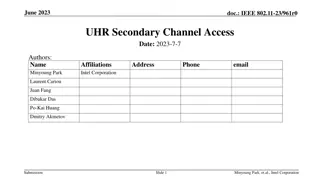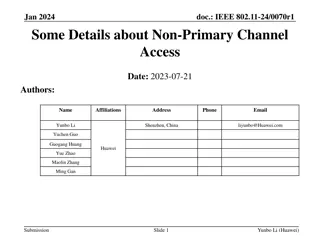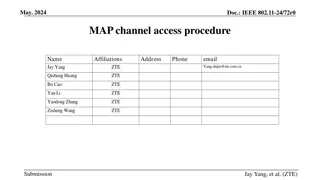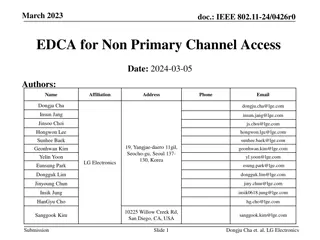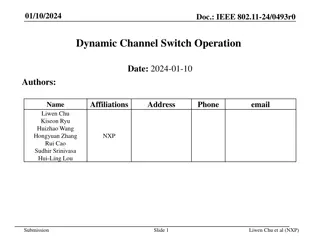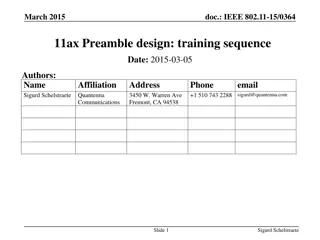NG60 channel modeling plan
This document discusses the NG60 channel modeling plan focusing on accurate space-time characterization, support for steerable directional antennas, MIMO modes, and non-stationary channel characteristics. It covers system-level and PHY-level models for different antenna setups and scenarios.
Download Presentation

Please find below an Image/Link to download the presentation.
The content on the website is provided AS IS for your information and personal use only. It may not be sold, licensed, or shared on other websites without obtaining consent from the author.If you encounter any issues during the download, it is possible that the publisher has removed the file from their server.
You are allowed to download the files provided on this website for personal or commercial use, subject to the condition that they are used lawfully. All files are the property of their respective owners.
The content on the website is provided AS IS for your information and personal use only. It may not be sold, licensed, or shared on other websites without obtaining consent from the author.
E N D
Presentation Transcript
May 2015 doc.: IEEE 11-15/0614r01 NG60 channel modeling plan Authors: Name Affiliation Address Phone Email Alexander Maltsev Intel +7(962)5050236 alexander.maltsev@intel.com Andrey Pudeyev Intel andrey.pudeyev@intel.com Ilya Bolotin Intel ilya.bolotin@intel.com Carlos Cordeiro Intel carlos.cordeiro@intel.com Submission Slide 1 Alexander Maltsev, Intel
May 2015 doc.: IEEE 11-15/0614r01 Agenda Channel model requirements NG60 use cases and modeling scenarios Experimental measurements Overview Plans Q-D channel model methodology Brief introduction Open area, Street canyon and Hotel lobby models 802.11ad and Q-D model application to NG60: areas for further development Summary / Next steps References Submission Slide 2 Alexander Maltsev, Intel
May 2015 doc.: IEEE 11-15/0614r01 NG60 Channel model requirements Accurate space-time characterization of the propagation channel for main use cases mmWave propagation features 3-dimensional model Support of steerable directional antennas with no limitations on the antenna technology Phased antenna arrays, modular antenna arrays Lens antennas / other prospective technologies MIMO modes support Both for SLS and LLS analysis Support of polarization characteristics of antennas and signals Antenna polarizations Polarization changes during reflections Support of non-stationary characteristics of the propagation channel. Mobility effects: Doppler effect from TX/RX motion, non-stationary environment Path blockage (probability) Channel model applicability to both system level simulation (SLS) and PHY level (LLS) analysis Slide 3 Submission Alexander Maltsev, Intel
May 2015 System level and Link (PHY) level models doc.: IEEE 11-15/0614r01 System level models Universal approach for any type/number of antennas Channel characteristics depend on the given TX/RX positions Should be used to produce PHY level model database (DB) PHY level models Explicit DB of channel impulse responses (CIR) realizations for all required scenarios MIMO implementation Option #1: SISO channel extension to MIMO case. Correlation parameters determined from SLS model and verified by experiments (3GPP SCM and TGn -alike methodology) Option #2: Extend DB by inclusion additional CIR pairs for typical MIMO setups (2x2 arrays and other) Submission Slide 4 Alexander Maltsev, Intel
May 2015 doc.: IEEE 11-15/0614r01 NG60 use cases summary [1] Propagation conditions # Applications and Characteristics Throughput Topology Priority (TBD) Ultra Short Range (USR) Communications -Static,D2D, -Streaming/Downloading LOS only, Indoor <10cm 1 ~10Gbps P2P Medium 8K UHD Wireless Transfer at Smart Home -Umcompressed 8K UHDStreaming Indoor, LOS with small NLOS chance, <5m 2 >28Gbps P2P High Augmented Reality and Virtual Reality -Low Mobility, D2D -3D UHD streaming Indoor, LOS with small NLOS chance <10m 3 ~20Gbps P2P Low Data Center NG60 Inter-Rack Connectivity -Indoor Backhaul with multi-hop* Indoor, LOS only <10m P2P P2MP 4 ~20Gbps Low Video/Mass-Data Distribution/Video on Demand System - Multicast Streaming/Downloading - Dense Hotspots Mobile Wi-Fi Offloading and Multi-Band Operation (low mobility ) -Multi-band/-Multi-RAT Hotspot operation Indoor, LOS/NLOS <100m P2P P2MP 5 >20Gbps Medium Indoor/Outdoor, LOS/NLOS <100m P2P P2MP 6 >20Gbps High Outdoor, LOS <200m P2P P2MP Mobile Fronthauling 7 ~20Gbps Low Wireless Backhauling with Single Hop -Small Cell Backhauling with single hop Outdoor, LOS <1km P2P P2MP 8 ~20Gbps Medium Wireless Backhauling with Multi-hop -Small Cell Backhauling with multi-hop* Outdoor, LOS <150m P2P P2MP 9 ~2Gbps Low Submission Slide 5 Alexander Maltsev, Intel
May 2015 doc.: IEEE 11-15/0614r01 Use cases vs. channel scenarios Use cases differs not only by environment, but also by throughput / latency / topology parameters, from the other hand, the same use cases may be realized in the different environments Channel modeling scenario Ultra-short range Use cases 1 Channel modeling approaches, comments Direct EM near-field calculation and measurements Los and device to device reflections new approach needed IEEE 802.11ad model [2] as a base Enhancements: MIMO modes, Doppler and mobility effects, TX- Rx positions are changing New static LOS scenario: Metallic constructions, ceiling reflections. No experimental data. LOS/NLOS, frequent human blockage, multiple reflections IEEE 802.11ad models for cubicle and conference room. Experimental measurements and ray tracing simulations required for models development (analysis of METIS, AIRBUS data, etc.) Open area channel model in MiWEBA Q-D methodology with extension to MIMO Street canyon channel model in MiWEBA Q-D methodology with extension to MIMO Living room 2, 3 Data center 4 Enterprise/Mall/Exhibition Transportation 5 Open area (Access/Fronthaul/Backhaul) Street canyon (Access/Fronthaul/Backhaul) 6,7,8,9 6,7,8,9 Submission Slide 6 Alexander Maltsev, Intel
May 2015 doc.: IEEE 11-15/0614r01 Experimental measurements Existing experimental measurements MiWEBA experimental campaigns (data available) [3,4] HHI measurements (street canyon, omni, 250 MHz BW) [5] IMC measurements (open area, directional, 800 MHz BW), [6] METIS experimental campaigns (raw data availability - TBD) ][7] Ericsson (indoor/office, directional, 2 GHz BW) Aalto (indoor: shopping mall, cafeteria; outdoor: dense urban omni/directional, 4 GHz BW), HHI (outdoor, omni, 250 MHz BW) Other experimental data may be available: NIST, Huawei, universities [8] Desirable additional experimental measurements Indoor/Outdoor data with high time domain resolution (2-4 GHz BW) for Intra-cluster time parameters identification: High priority Indoor/Outdoor data with high angular domain resolution (synthesized aperture, very large antennas, etc.) for Intra-cluster angular parameters identification: Low priority Indoor/Outdoor data for closely placed antennas for SU-MIMO channel analysis: High priority Submission Slide 7 Alexander Maltsev, Intel
May 2015 doc.: IEEE 11-15/0614r01 Q-D channel model basics Joint map-based and statistical approach [9,10] Parameters of the most strongest rays (D-rays) in the given scenario explicitly obtained via ray- tracing, reflection coefficients and pathloss calculations (Fresnel formulas and Friis equation) Random / weaker rays (R-rays) parameters taken from the pre-defined statistical distributions (Poisson ToA, exponentially-decaying PDP, etc.) Intra-cluster structure of the D- and R-rays built on the base of statistical distributions Currently three basic implemented in MiWEBA project: open-area, street canyon, hotel lobby, with access and backhaul links support (open-area model used for MU-MIMO performance evaluation in a small cells environment [11,12]) power LOS ray K D-rays Random rays average power R-rays & clusters Reflected ray D-ray cluster T0 T0+ 1 time 1/ scenarios were Submission Slide 8 Alexander Maltsev, Intel
May 2015 Open-area access channel model: D-rays doc.: IEEE 11-15/0614r01 Compon ent D-rays: Direct LOS ray and Ground-reflected ray D-Rays calculated from geometry, taking into account pathloss, reflection loss (Fresnel + scattering), and polarization Parameter Value Direct ray delay is calculated from the model geometry: = / d c Delay D0 D ( )2 = + 2 d L H H D tx rx Direct ray power calculated as free-space pathloss with oxygen absorption Direct Power = 20 log 10 P A d , in dB 4 d D0 0 0 0 0 azimuth and elevation AoD 0 azimuth and elevation AoA Delay Ground-reflected ray delay is calculated from the model geometry: = / d c G0 G ( )2 Far reflector = + + 2 d L H H G tx rx 3 sector BS Power Ground-reflected power calculated as free-space pathloss with oxygen absorption, with additional reflection loss calculated on the base of Fresnel equations Far wall ray, di = + + 20 log 10 P A d R F sin 4 d G0 0 G G Random ray, dj f B = 20 log 10 R Htx Direct ray, dD f + sin B Ground ray, dG f = ( f ) f 2 cos B for horizontal polarization r Ground = 2 2 r cos / B for vertical polarization r Random reflector and f is a grazing angle ( H tx ) tan( = f ) L / + H rx Hrx 2 f sin 80 g = L , in dB F log 10 Azimuth: 0 Elevation: H H AoD ( ) ( ) = + arctan / arctan / L L H H AoD tx rx tx rx Azimuth: 0 Elevation: ) L H rx / + AoA ( ( ) = + + arctan arctan / H H H L AoA tx tx rx Submission 9
May 2015 Open-area access channel model: R-rays doc.: IEEE 11-15/0614r01 R-rays R-rays are generated as Poisson processes with exponentially decaying profile AoA and AoD are uniformly distributed within limits Intra-cluster components Applied to both D-rays and R-rays Arrival also modeled as Poisson process AoA and AoD modeled as independent normally distributed random variables around the central ray with RMS equal to 50 * Parameter Value Number of clusters, Ncluster 3 0.05ns-1 Cluster arrival rate, Cluster power-decay constant, 15ns K-factor 6dB Elevation: U[AOAG0:AOAD0] Azimuth: U[-60:60 ] AOA Elevation: U[AODG0:AODD0] Azimuth: U[-60:60 ] AOD * Parameter Value Post-cursor rays K-factor, K 6 dB for LOS ray, 4 dB for NLOS* Post-cursor rays power decay time, 4.5 ns 0.31 ns-1 Post-cursor arrival rate, Post-cursor rays amplitude distribution Rayleigh Number of post-cursor rays, N 4 *Note: Parameters may be refined by new experimental measurement results Submission 10
May 2015 doc.: IEEE 11-15/0614r01 Street canyon access channel model The ray-tracing analysis shows that in street canyon scenario only 4 rays have significant impact on the signal power (D- rays): Direct LOS ray Ground ray Nearest wall ray Ground-Nearest wall ray 4,5m Access points UE drop areas Sidewalk #2 100m Building #1 Road Building #2 4,5m Sidewalk #1 0,5m 0,5m 50m 4,5m 6,0m 16,0m 6,0m Reflected rays power PDF Submission 11
May 2015 doc.: IEEE 11-15/0614r01 Street canyon access channel model D-ray parameters definition is similar to Open-area case: Direct ray, two first order reflections and one second-order reflection are calculated from the geometry and material parameters (see table) R-rays: Poisson Intra-cluster components: Poisson Parameter Value AP height, Htx 6 m UE height, Hrx 1.5m AP distance from nearest wall, Dtx 4.5 m Sidewalk width 6 m Road width 16 m Street length 100 m Wall-reflected RX image AP-AP distance, same side 100 m AP-AP distance, different sides 50 m TX Road and sidewalk material asphalt Road and sidewalk r 4+0.2j RX Road and sidewalk roughness g (standard deviation) 0.2 mm Building walls material concrete Ground and wall reflected RX image Building walls r 6.25+0.3j Building walls roughness w (standard deviation) 0.5 mm Ground reflected RX image Submission 12
May 2015 doc.: IEEE 11-15/0614r01 Hotel lobby access Access point The ray tracing analysis of the hotel lobby shows that in such bordered area all rays up to second order are significant and should be treated as D- rays R-rays represents reflections from various objects in the room. Modeled as Poisson distribution with specified parameters Intra-cluster parameters are taken from 802.11ad 60GHz indoor channel model. 0,2m UE drop area 10,0m 1,0m 5,0m 15,0m Submission 13
May 2015 doc.: IEEE 11-15/0614r01 Backhaul and D2D channel models ART Backhaul scenario Backhaul link between two ART relay stations typically armed with very high gain and high directional antennas. This leads to the absolute dominance of the direct LOS ray, and the other rays (which may present in this environment) are much weaker. D-Ray: LOS component plus small cluster Street canyon backhaul/fronthaul The Street canyon backhaul/fronthaul channel model is derived from the Street canyon access channel models by setting RX antenna height equal to AP height. The other parameters are not changed. D2D channel models D2D channel models for Open area, Street canyon and Hotel lobby are derived from the corresponding access channel models by setting TX antenna height equal to UE height. The other parameters are not changed. Submission 14
May 2015 802.11ad and Q-D model application for NG60: areas for development Update 802.11ad and Q-D model to support all NG60 use cases MIMO mode support D-rays parameters are calculated on the base of antenna positions R-rays parameters correlation for closely spaced antennas need to be defined Channel bonding Check for potential issues for double-band channels (4GHz) Intra-cluster parameters update For now, all intra-cluster parameters are taken directly from IEEE 802.11ad channel model Intra-cluster parameters need to be refined for all new scenarios and use cases on the base of experimental measurements and ray- tracing doc.: IEEE 11-15/0614r01 Submission Slide 15 Alexander Maltsev, Intel
May 2015 doc.: IEEE 11-15/0614r01 Summary / Next steps Organization issues Summary of existing models Summary of available measurement results Identifying required experimental campaigns Q-D channel model update New scenarios Intra-cluster structure verification MIMO mode / antenna signals correlation support Submission Slide 16 Alexander Maltsev, Intel
May 2015 doc.: IEEE 11-15/0614r01 References 1. NG60 usage scenarios , http://mentor.ieee.org/802.11/dcn/14/11-14-1185-00-ng60-ng60-usage-scenarios.pptx 2. "Channel Models for 60 GHz WLAN Systems," IEEE 802.11ad 09/0334r8, 2010. 3. MiWEBA Project #608637 homepage: http://www.miweba.eu, FP7-ICT-2013-EU-Japan, 2013 4. MiWEBA project #608637, Deliverable D5.1, Channel Modeling and Characterization , Public Deliverable, Intel Editor, June 2014. 5. R. J. Weiler, M. Peter, W. Keusgen, H. Shimodaira, K. T. Gia and K. Sakaguchi, "Outdoor Millimeter-Wave Access for Heterogeneous Networks Path Loss and System Performance," in PIMRC, 2014. 6. A. Maltsev, A. Pudeyev, I. Karls, I. Bolotin, G. Morozov , R.J. Weiler, M. Peter, W. Keusgen, M. Danchenko, A. Kuznetsov, WWRF 33, 2014, Guildford, GB, Quasi-Deterministic Approach to MmWave Channel Modeling in the FP7 MiWEBA Project 7. METIS 2020 channel model deliverable 1.4:http://www.metis2020.com/documents/deliverables 8. T. S. Rappaport, et.al., "Broadband Millimeter-Wave Propagation Measurements and Models Using Adaptive- Beam Antennas for Outdoor Urban Cellular Communications," IEEE Trans. on Antennas and Propagation, vol. 61, pp. 1850-1859, 2013. 9. Channel models for NG60 , http://mentor.ieee.org/802.11/dcn/14/11-14-1486-00-ng60-channel-models-in- ng60.pptx 10. A. Maltsev, A. Pudeyev, I. Karls, I. Bolotin, G. Morozov , R.J. Weiler, M. Peter, W. Keusgen Quasi-deterministic Approach to mmWave Channel Modeling in a Non-stationary Environment , IEEE GLOBECOM 2014, Austin, Texas, USA 11. MU-MIMO-schemes for NG60 , http://mentor.ieee.org/802.11/dcn/15/11-15-0356-00-ng60-mu-mimo-schemes- for-ng60.pptx 12. A. Maltsev, A. Sadri, A. Pudeyev, A. Davydov, I. Bolotin, G. Morozov, Performance evaluation of the MmWave Small Cells communication system in MU-MIMO mode , EuCNC 2015 Submission Slide 17 Alexander Maltsev, Intel
